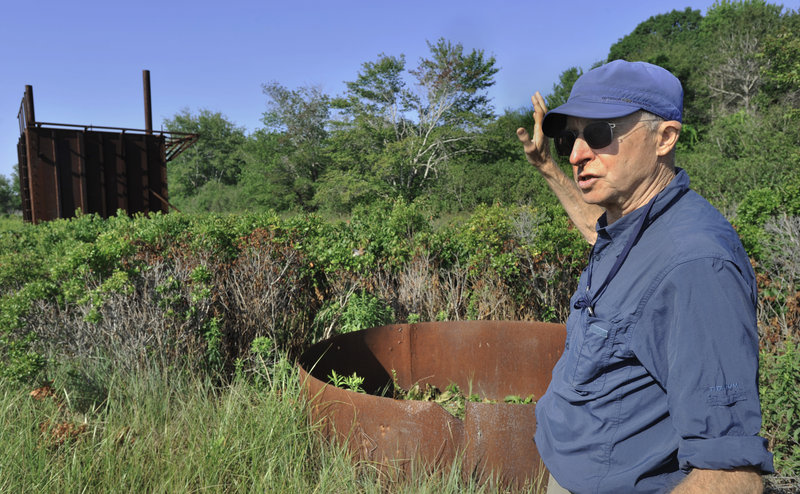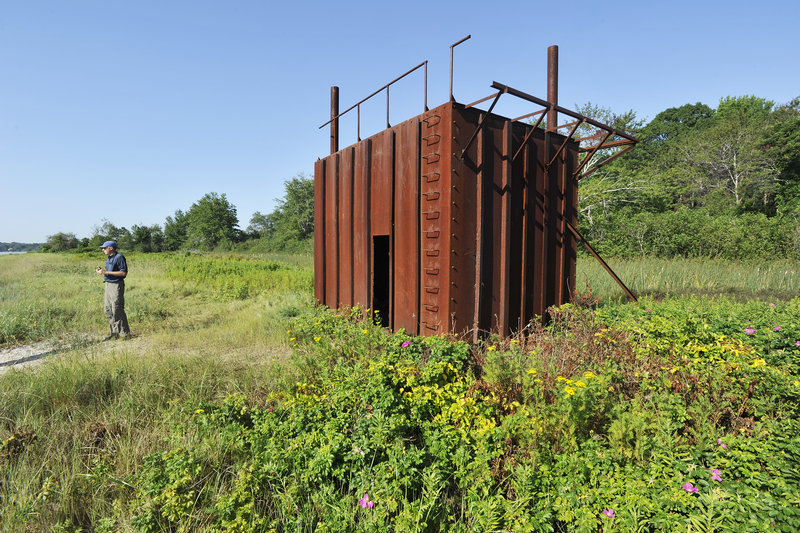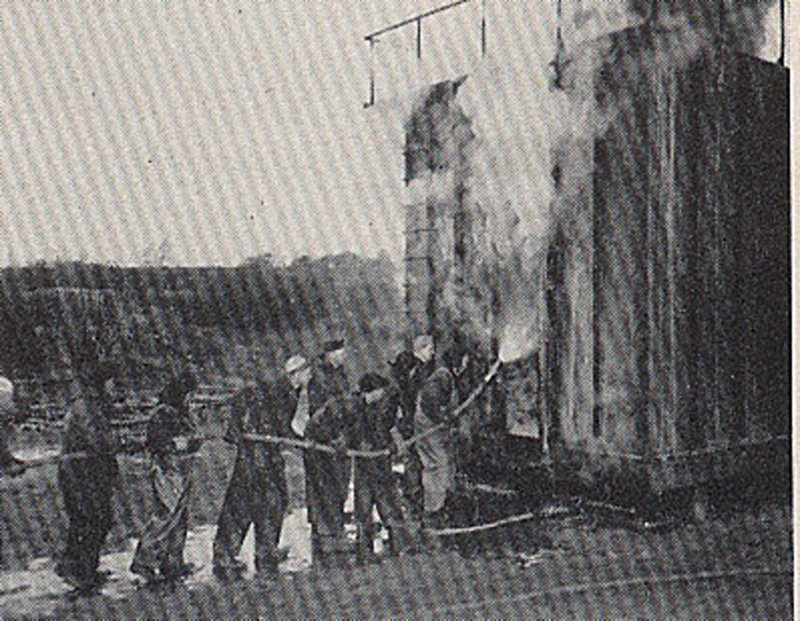LITTLE CHEBEAGUE ISLAND – From outside the firefighter training structure, young sailors felt searing heat radiating from the metal walls. They smelled burning oil and, when the doors were pulled open, saw thick smoke and leaping flames.
Their mission: Grab hoses that sprayed a fog of seawater and douse the inferno.
“When it was out, you said, ‘Good God, I’m alive and I can do it,’” said Erno Bonebakker. “And that was the point.”
Bonebakker recently described the exercises that were held on the sandy beach here during World War II, when the Navy turned this Casco Bay island into a training and recreation center.
With its battleships under attack, the Navy wanted every sailor to be trained to put out fires. Globally, it built more than 100 of the steel structures, meant to simulate a ship’s machinery compartment.
Instructors set fire to oil floating on water under the floor grate. From 1943 to 1945, about 15,000 sailors were taught how to put out the flames on Little Chebeague.
Today, few of the training structures remain. Bonebakker, who got identical training while serving with the Coast Guard in Japan in 1969, wants people to understand how this now-uninhabited, 86-acre island played a crucial role in naval training nearly 70 years ago.
Using vintage photographs from the National Archives in Boston, he has assembled an online exhibit in the Maine Historical Society’s digital museum, the Maine Memory Network.
The exhibit and slide show, “Navy Firefighting School, Little Chebeague Island,” complements a larger effort by the Maine Island Trail Association, the Maine Department of Conservation and others to enhance the experience for visitors to this state-owned island.
Bonebakker and the Maine Island Trail Association are working this summer to upgrade interpretive signs, including one at the firefighter structure. Two kiosks are being installed with additional information.
In time, the words and pictures on the signs will include links to digital presentations on the Internet, which visitors will be able to access with smartphones.
Facing the eastern beach, the firefighter training structure is a curious fixture in Casco Bay, easily spotted by ferry passengers and recreational and commercial boaters. Essentially a steel box, 13 feet tall, 12 feet wide and 18 feet long, its purpose and origins are a mystery to many.
Drifting smoke has been replaced by barn swallows gliding in and out of the rusted door openings. Ladder rungs lead to what’s left of catwalks and railings, and two chimney stacks. The metal floor grate has been filled in by sand.
“It worked like a great big oil stove,” Bonebakker said.
Nearby, a rusted metal ring sits in the dune grass. Bonebakker recognizes it as an open fire pan, the steel bottom now covered by sand.
“The story really starts here,” he said, showing how trainees practiced on an oil fire in the pan before moving to the structure. “Every sailor needed to be a firefighter. To do that, you had to take the fear of fire out of the sailor.”
The history of the firefighter structure is a footnote in the wider story of Casco Bay’s role as a base for the North Atlantic fleet during World War II.
During those years, Little Chebeague was transformed from an old hotel site and string of summer cottages to a military recreation center, with ball fields, boxing rings and a bowling alley. Sailors were served lobster dinners before shipping out to escort convoys.
The island was neglected for decades after the military left. The state bought it in the 1970s, but money to develop it as a park was never approved.
The Maine Island Trail Association began cutting trails and clearing campsites in the 1990s, led by Richard Innes, a volunteer from Portland who also wrote a history of the island.
Bonebakker, a retired attorney and former association board member with a home on adjacent Chebeague Island, is picking up where Innes left off.
Bonebakker’s effort is appreciated by the Maine Historical Society, which helped support the online presentation. As time goes by, it becomes harder to imagine Casco Bay as a concentration of forts, fuel depots and other military installations, said Steve Bromage, the society’s executive director. The firefighter structure is an enduring reminder of World War II’s history, he said.
Creating online links to the sites is an exciting concept, which will increasingly be made available to recreational travelers, Bromage said.
“When people are kayaking and they encounter something, they expect to plug into their mobile device and learn more,” he said.
That idea reflects the evolving thinking of the Maine Island Trail Association. The organization has worked to enhance camping and access for small boats along the Maine coast, and is coming to appreciate the broader interests of its members.
Little Chebeague is a good test site. It’s the second most visited destination on the island trail in Casco Bay, behind state-owned Jewell Island.
The association “has focused on recreation,” said Brian Marcaurelle, the group’s program director. “But we’re finding our members are interested in the rest of the story. We’re just beginning to dig into that.”
Staff Writer Tux Turkel can be contacted at 791-6462 or at:
tturkel@pressherald.com
Send questions/comments to the editors.






Success. Please wait for the page to reload. If the page does not reload within 5 seconds, please refresh the page.
Enter your email and password to access comments.
Hi, to comment on stories you must . This profile is in addition to your subscription and website login.
Already have a commenting profile? .
Invalid username/password.
Please check your email to confirm and complete your registration.
Only subscribers are eligible to post comments. Please subscribe or login first for digital access. Here’s why.
Use the form below to reset your password. When you've submitted your account email, we will send an email with a reset code.